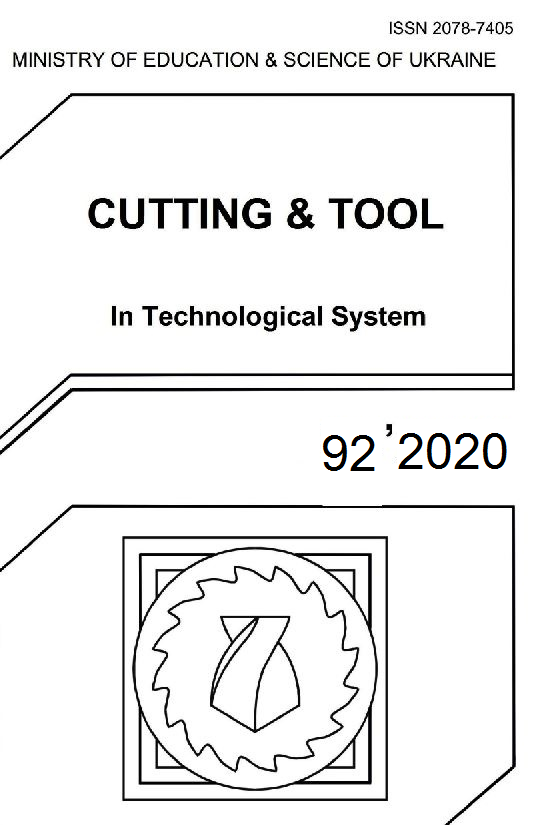CHANGES IN THE VALUES OF ROUGHNESS PARAMETERS ON FACE-MILLED STEEL SURFACE
DOI:
https://doi.org/10.20998/2078-7405.2020.92.10Keywords:
face milling, surface roughness, distribution of roughness.Abstract
. In this paper, the roughness characteristics of the face milled surface were investigated made with a parallelogram insert (κr = 90°) on C45 steel. Changes in surface roughness were analyzed for the specific surface created by the milling movement conditions (rotational main movement and linear feed motion). The topography was created by a tool moving in the plane of symmetry of the workpiece, which produced double cutting-edge grooves. We found that the roughness varies in different parts of the resulting pattern, and we analyzed its nature and the magnitude of the variance based on the average over the entire surface. Also, in parallel measurements, the Rz parameter was at its maximum in the symmetry plane, and in the perpendicular direction roughness values are the lowest in the middle and increase with distance.References
Bhardwaj, B., Kumar, R., Singh, P.K.: An improved surface roughness prediction model using Box-Cox transformation with RSM in end milling of EN 353, Journal of Mechanical Science and Technology 28(12), pp.5149-5157. (2014).
Subramanian, M., Sakthivel, M., Sudhakaran, R.: Modeling and analysis of surface roughness of AL7075-T6 in end milling process using response surface methodology, Arabian Journal for Science and Engineering 39(10), pp.7299-7313. (2014).
Sheth, S., George, P.M.: Experimental investigation and prediction of flatness and surface roughness during face milling operation of WCB material, Procedia Technology 23, pp.344-351. (2016).
Benardos, P.G., Vosniakos, G.C.: Prediction of surface roughness in CNC face milling using neural networks and Taguchi's design of experiments, Robotics and Computer-Integrated Manufacturing 18, pp.343-354. (2002).
Baek, D.K., Ko, T.J., im, H.S.: Optimization of feedrate in a face milling operation using a surface roughness model, International Journal of Machine Tools and Manufacture 41, pp.451-462. (2001).
Filho, C.J., Diniz, A.E.: Influence of cutting conditions on tool life, tool wear and surface finish in the face milling process, Journal of the Brazilian Society of Mechanical Sciences 24, pp.10-14. (2002).
Gong, F., Zhao, J., Jiang, Y., Tao, H., Li, Z., Zang, J.: Fatigue failure of coated carbide tool and its influence on cutting performance in face milling SKD11 hardened steel, International Journal of Refractory Metals and Hard Materials 64, pp.27-34. (2017).
Felhő, C., Kundrák, J.: Effects of setting errors (insert run-outs) on surface roughness in face milling when using circular inserts, Machines 6(2), 14. (2018).
Felhő, C., Nagy, A., Kundrák, J.: Effect of Shape of Cutting Edge on Face Milled Surface Topography, Proceedings of the International Symposium for Production Research 2019, pp.525-534. Springer, Cham, 2019.
Nagy, A., Kundrak, J.: Investigation of surface roughness characteristics of face milling, Rezanie I Instrumenty V Tekhnologicheskih Sistemah 90, pp. 63-72. (2019).
Nagy, A., Kundrak, J.: Effect of cutting speed on surface roughness: face milling of steel with a parallelogram insert, MultiScience - XXXIII. microCAD International Multidisciplinary Scientific Conference, Miskolc-Egyetemváros, Magyarország, 2019., Paper: D1-4, pp. 1-10.
Smith GT. Cutting Tool Technology: Industrial Handbook. London: Springer, 2008.
Felhő, C., Karpuschewski, B., Kundrák, J.: Surface roughness modelling in face milling, PROCEDIA CIRP 31, pp. 136-141., (2015).
Kundrak, J., Nagy, A., Markopoulos, A.P., Karkalos, N.E.: Investigation of surface roughness on face milled parts with round insert in planes parallel to the feed at various cutting speeds, Rezanie I Instrumenty V Tekhnologicheskih Sistemah 91, pp. 87-96. (2019).
European Steel and Alloy Grades, C45, https://tinyurl.hu/GtDr/
Downloads
Published
Issue
Section
License
Copyright Notice
Authors who publish with this Collection agree to the following terms:
1. Authors retain copyright and grant the Collection right of first publication with the work simultaneously licensed under a Creative Commons Attribution License that allows others to share the work with an acknowledgement of the work's authorship and initial publication in this Collection.
2. Authors are able to enter into separate, additional contractual arrangements for the non-exclusive distribution of the Collection's published version of the work (e.g., post it to an institutional repository or publish it in a book), with an acknowledgement of its initial publication in this Collection.
3. Authors are permitted and encouraged to post their work online (e.g., in institutional repositories or on their website) prior to and during the submission process, as it can lead to productive exchanges, as well as earlier and greater citation of published work.

